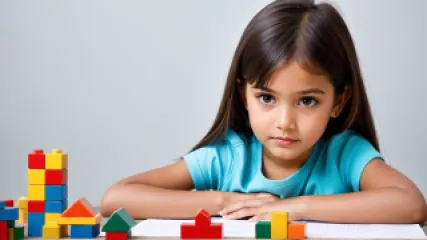Unlocking Child Psychology: A Research-Backed Exploration
Unlocking Child Psychology: A Research-Backed Exploration
Child psychology is a vast and complex field, encompassing the cognitive, emotional, social, and behavioral development of young individuals. As we delve into this fascinating realm, we'll embark on a research-backed exploration that aims to shed light on the intricate workings of the child's mind and the factors that shape their growth. From the early stages of development to the unique challenges faced during adolescence, this article will guide you through a comprehensive understanding of child psychology.
Understanding the Foundations of Child Psychology
At the core of child psychology lies the fundamental question: what shapes the way children think, feel, and behave? To answer this, we must explore the various theoretical frameworks that have emerged over the years, each offering a unique perspective on the subject.
One of the most influential theories in child psychology is the psychoanalytic approach, pioneered by Sigmund Freud. Freud's idea of the unconscious mind, the id, ego, and superego, and the importance of early childhood experiences in shaping personality have had a lasting impact on the field. While Freud's theories have been subject to much debate and criticism, they continue to provide a valuable starting point for understanding the complexities of child development.
Another influential theory in child psychology is the cognitive-developmental approach, championed by Jean Piaget. Piaget's groundbreaking work on the stages of cognitive development, from sensorimotor to formal operational, has revolutionized our understanding of how children's thought processes evolve over time. His emphasis on the active role of the child in constructing their own knowledge has challenged traditional views of learning and development.
The Role of Attachment in Child Psychology
Attachment theory, pioneered by John Bowlby and Mary Ainsworth, has emerged as a critical component in understanding child psychology. This theory posits that the quality of the bond between a child and their primary caregiver(s) has a profound impact on the child's emotional, social, and cognitive development.
According to attachment theory, children who experience secure attachment, characterized by a responsive and consistent caregiver, are more likely to develop a strong sense of self, healthy emotional regulation, and the ability to form meaningful relationships later in life. In contrast, children who experience insecure attachment, marked by inconsistent or unresponsive caregiving, may struggle with issues such as anxiety, difficulty trusting others, and challenges in regulating their emotions.
The implications of attachment theory are far-reaching, as it emphasizes the crucial role of early childhood experiences in shaping an individual's psychological well-being and interpersonal functioning. Understanding the dynamics of attachment can inform parenting practices, educational approaches, and mental health interventions aimed at supporting children's healthy development.
Exploring the Developmental Stages of Childhood
Child psychology encompasses the various stages of development, each with its own unique characteristics and challenges. By understanding these stages, we can gain valuable insights into the cognitive, emotional, and social milestones that children achieve as they grow.
Infancy (0-2 years)
During the infancy stage, children undergo rapid physical, cognitive, and social-emotional development. This period is marked by the development of sensory and motor skills, the emergence of attachment bonds, and the beginnings of language acquisition. Infants rely heavily on their senses to explore the world around them, and their interactions with caregivers play a crucial role in shaping their early experiences and foundational understanding of the world.
Early Childhood (3-6 years)
The early childhood stage is characterized by significant cognitive, social, and emotional growth. Children in this period begin to develop a sense of self, engage in more complex play and social interactions, and demonstrate increased language proficiency. They also start to exhibit more independent problem-solving skills and a growing understanding of rules and social norms.
Middle Childhood (7-11 years)
During middle childhood, children experience a gradual shift in their cognitive and social development. They become more logical, organized, and capable of abstract thinking, which allows them to engage in more complex problem-solving and decision-making. This stage also marks the development of stronger peer relationships, a growing sense of self-identity, and the ability to understand and regulate their own emotions more effectively.
Adolescence (12-18 years)
Adolescence is a pivotal and often tumultuous stage of development, characterized by significant physical, cognitive, and social-emotional changes. During this period, young individuals navigate the challenges of identity formation, increased independence, and the heightened importance of peer relationships. Adolescents also experience a surge in hormonal changes that can impact their mood, behavior, and overall well-being.
The Impact of Environmental Factors on Child Development
While the stages of child development provide a valuable framework for understanding the inherent changes and milestones, it is crucial to recognize the significant role that environmental factors play in shaping a child's psychological well-being and overall development.
Family Dynamics
The family environment, including the quality of relationships within the household, the parenting styles employed, and the overall family structure, can have a profound impact on a child's development. Factors such as parental attachment, communication patterns, and the presence of supportive or stressful family dynamics can all influence a child's emotional, social, and cognitive growth.
Socioeconomic Status
Socioeconomic status (SES) is another key environmental factor that can shape a child's psychological development. Children from low-SES backgrounds may face challenges such as limited access to resources, increased exposure to stress and adversity, and fewer opportunities for enrichment activities. These factors can contribute to disparities in cognitive, academic, and social-emotional outcomes.
Cultural and Community Influences
The cultural and community context in which a child is raised also plays a significant role in their psychological development. Cultural values, traditions, and societal norms can influence a child's beliefs, behaviors, and overall worldview. Additionally, the availability of community resources, such as educational, recreational, and mental health support, can significantly impact a child's growth and well-being.
The Importance of Early Intervention and Prevention
Child psychology emphasizes the critical importance of early intervention and prevention in addressing developmental challenges and promoting healthy growth. By identifying potential issues or risk factors early on, professionals and caregivers can implement targeted strategies to support children's needs and foster their overall well-being.
Early Childhood Interventions
Early childhood interventions, such as specialized educational programs, family-based therapies, and targeted support for developmental delays or disabilities, can have a profound impact on a child's trajectory. These interventions aim to address issues early on, preventing them from escalating and potentially leading to more severe difficulties in the future.
Prevention and Promotion of Positive Mental Health
In addition to addressing specific challenges, child psychology also emphasizes the importance of preventive measures and the promotion of positive mental health. This includes fostering resilience, emotional regulation, and healthy coping strategies in children, as well as providing support and education to parents and caregivers. By prioritizing the overall well-being of children, we can help them develop the skills and resources needed to navigate the complexities of childhood and adolescence.
Emerging Trends and Future Directions in Child Psychology
As the field of child psychology continues to evolve, researchers and practitioners are exploring new frontiers and addressing emerging challenges. From the integration of technology in assessment and intervention to the growing emphasis on cultural competence and diversity, the landscape of child psychology is constantly shifting to meet the needs of contemporary youth.
Technological Advancements
The integration of technology in child psychology has opened up new avenues for assessment, intervention, and research. Digital tools, such as virtual reality, mobile applications, and online platforms, are being utilized to enhance diagnostic processes, provide more accessible therapeutic services, and gather valuable data on child development and behavior.
Cultural Competence and Diversity
As the world becomes increasingly globalized, child psychology is also undergoing a shift towards greater cultural competence and recognition of diversity. Researchers and practitioners are now exploring the unique experiences and needs of children from diverse cultural, ethnic, and socioeconomic backgrounds, ensuring that interventions and support systems are tailored to the specific contexts and challenges they face.
Interdisciplinary Collaborations
The field of child psychology is also embracing a more interdisciplinary approach, collaborating with other fields such as neuroscience, pediatrics, and education to gain a more comprehensive understanding of child development and well-being. These collaborations facilitate the integration of cutting-edge research, innovative treatment modalities, and holistic approaches to supporting the needs of children and their families.
Conclusion
In the vast and captivating realm of child psychology, we have embarked on a research-backed exploration that has illuminated the intricate workings of the child's mind and the multifaceted factors that shape their growth. From the foundational theories that have laid the groundwork for our understanding to the emerging trends that are shaping the future of this field, we have delved into the complexities of child development, the role of attachment, the impact of environmental influences, and the importance of early intervention and prevention.
As we conclude this journey, it is clear that child psychology is a dynamic and ever-evolving discipline, one that holds the key to unlocking the full potential of our young individuals. By continuing to explore the depths of child psychology, we can better support the mental well-being and overall flourishing of children, empowering them to navigate the challenges of childhood and adolescence with resilience, self-awareness, and a deep understanding of their own unique minds and experiences.
About the Author:
Gino Thomas is a seasoned child psychologist with over a decade of experience in the field. He has dedicated his career to understanding the complex dynamics of child development and advocating for the mental well-being of young individuals. Gino's research-driven approach and his passion for empowering children and their families have made him a respected voice in the field of child psychology.






